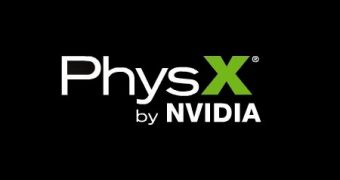PhysX middle-ware is used to simulate the laws of physics on a variety of platforms, such as PCs and game consoles (Xbox 360 and PS3), and is meant to add realism and, obviously, improve the overall gaming experience. Most processing of such effects is performed by the x86 CPU that powers said platforms. Some games, however, can take advantage of NVIDIA GeForce GPUs' ability to handle physics computing using CUDA, NVIDIA's proprietary API that, naturally, is not supported by ATI cards.
The lack of PhysX support on AMD adapters gives NVIDIA GeForce adapters a certain edge on the gaming hardware market. On the other hand, not many game developers use GPU PhysX exactly because AMD cards cannot handle it. In seeking to make its API more universal, NVIDIA was planning, last year, to port it to OpenCL. Doing so would allow any graphics card to perform the necessary computations even in the absence of CUDA.
“In the future it is a possibility that we could use OpenCL, but at the moment CUDA works great. [Our GPU] architecture allows for acceleration by other things like OpenCL. Nvidia works very closely with The Khronos Group, actually Neil Trevett is president of the group and he’s part of Nvidia, so we’ve been driving that standard also, and it’s an excellent standard,” Nadeem Mohammad, a director of PhysX product management at Nvidia, said in an interview with Bit-tech, last year.
Porting PhysX to OpenCL definitely has its advantages, but, as with all steps forward, there seems to be a catch. While NVIDIA can create a version of GPU PhysX that does not rely on CUDA, how well it runs will be determined by the graphics processor's actual GPU computing capabilities. In regards to AMD adapters, NVIDIA says that there may be some performance issues.
“If we start using OpenCL, then there’s a chance that the features would work on ATI, but I have no idea what the performance would be like. Previously, looking at things like Folding@home, ATI GPU computing performance seems to be behind Nvidia. That probably reflects the fact that their GPU computing solution is probably a couple of generations behind ours,” Mr. Mohammad explained.
There hasn't been much in the way of updates on this endeavor recently but there may be some factors that could affect NVIDIA's enthusiasm in making this platform more universal. ATI's Cypress GPUs were a milestone for AMD and the ATI Stream technology has become more adpet over the past year. This means that Radeon adapters may actually have little to no problem with PhysX now. If PhysX does become universal, game makers will have one less reason to optimize their titles for NVIDIA cards, removing the latter's edge in this segment while making the middle-ware more widespread. This tradeoff may or may not be worthwhile.

 14 DAY TRIAL //
14 DAY TRIAL //